
Bees are among the most vital pollinators in the world, responsible for pollinating about a third of the food we consume. These small but mighty creatures play a critical role in maintaining the health and diversity of plant life, supporting ecosystems, and sustaining agricultural production. Illinois, the Prairie State, is home to a remarkable variety of bee species, each with unique behaviors, appearances, and ecological roles. Despite their importance, bees face numerous threats, including climate change, disease, pesticide exposure, and habitat loss. As bee populations decline, it becomes increasingly important for us to understand and appreciate these fascinating insects and the essential work they do. In this article, we provide an in-depth look at ten diverse bee species found in Illinois, focusing on their physical characteristics, nesting habits, and swarming behaviors.
1. Honey Bees (Apis mellifera)
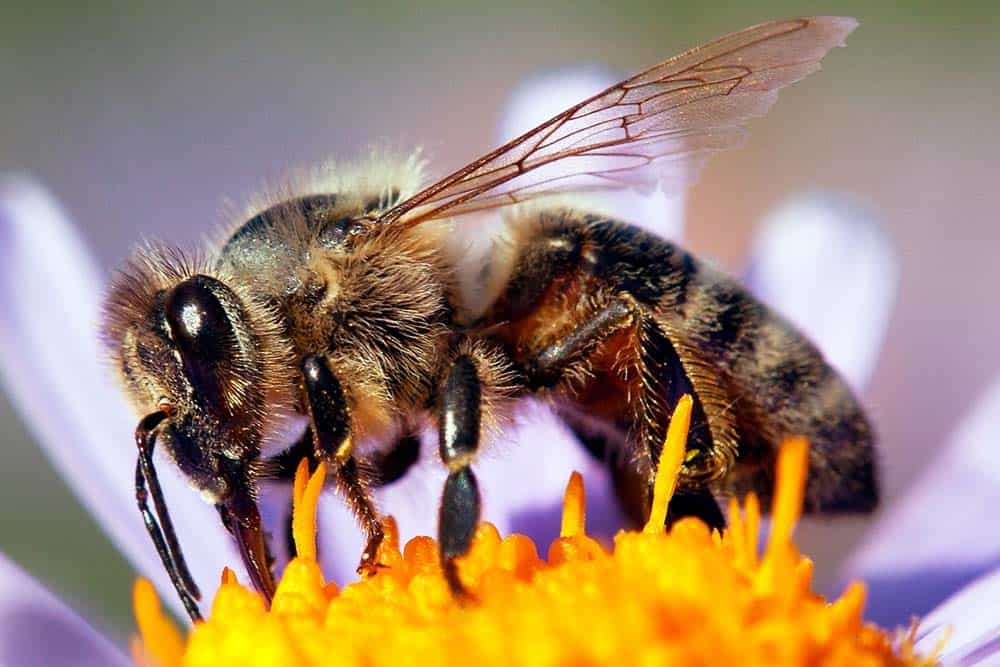
Honey bee.
©Daniel Prudek/Shutterstock.com
Honey bees, known scientifically as Apis mellifera, are perhaps the most well-known and widely recognized bee species. Originally native to Europe, the Middle East, and Africa, European settlers introduced them to North America in the 17th century.
Physical Characteristics
Honey bees are typically characterized by their golden-brown color with black abdominal stripes. Worker bees, the female bees responsible for foraging and maintaining the hive, have specialized structures like pollen baskets on their hind legs and a barbed stinger for defense. Queen bees are larger than workers, while male bees, or drones, are characterized by larger eyes and a lack of a stinger.
Where They Swarm in Illinois
Honey bees are adaptable and lives throughout Illinois, inhabiting both rural and urban environments.
They often establish their hives in:
- Hollow trees
- Rock crevices
- Man-made structures
Swarms occur when a colony becomes overcrowded, prompting the queen and a group of workers to leave the hive in search of a new nesting site.
2. Bumblebees (Bombus spp.)
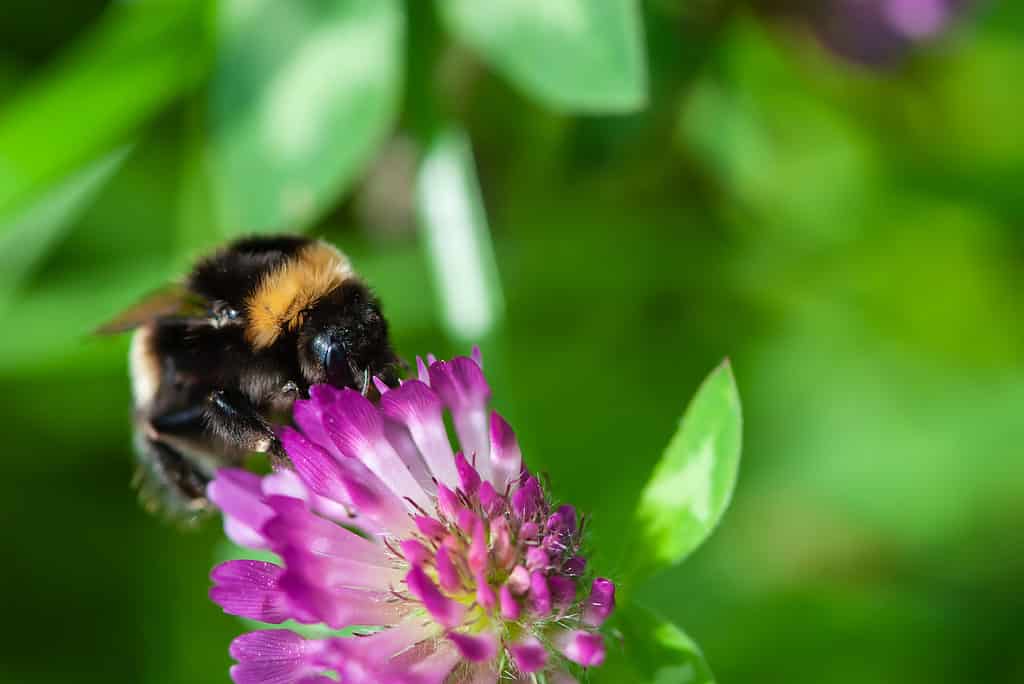
Close-up striped orange bumblebee and purple inflorescence of violet clover, trefoil in spring on a sunny day on green background
©iStock.com/Tanja Nik
Bumblebees belonging to the genus Bombus are easily recognizable by their robust, fuzzy appearance and distinctive buzz.
Physical Characteristics
Bumblebees are typically larger and more robust than honey bees, with round bodies covered in dense hair. They come in various colors and patterns, often featuring black, yellow, and orange markings. Bumblebees have strong wings that produce their signature buzzing sound as they fly. Female bumblebees possess a stinger for defense.
Where They Swarm in Illinois
Bumblebees thrive throughout Illinois, from rural areas to urban environments. They especially enjoy habitats with diverse and abundant floral resources, such as:
- Meadows
- Gardens
- Forest edges
Swarming in bumblebees is less common than in honey bees, and it usually occurs when virgin queens and males leave the nest to mate.
Species Found in Illinois
There are several bumblebee species in Illinois, including:
- The common eastern bumblebee (Bombus impatiens)
- The two-spotted bumblebee (Bombus bimaculatus)
- The brown-belted bumblebee (Bombus griseocollis)
Each species has its own preferred habitat, food sources, and nesting requirements.
3. Large Carpenter Bees (Xylocopa spp.)

Large carpenter bee.
©Zety Akhzar/Shutterstock.com
Large carpenter bees, members of the genus Xylocopa, are solitary bees that prefer nesting in wood. Although they can sometimes be mistaken for bumblebees due to their size and coloration, large carpenter bees have a more streamlined appearance, with less hair on their abdomens.
Physical Characteristics
Carpenter bees are large, robust insects that range in size from half an inch to over an inch in length. They have a shiny, mostly hairless abdomen, which is often black or metallic blue in color. Males have white or yellow markings on their faces, while females possess a stinger for defense.
Where They Swarm in Illinois
Large carpenters are common throughout Illinois, inhabiting both urban and rural environments. They seem to prefer wooden structures, such as houses, decks, and fences, where they can create their nests. Swarming behavior in large carpenter bees is relatively rare, as these solitary insects typically disperse to find suitable nesting sites rather than forming large groups.
Species Found in Illinois
The eastern carpenter bee (Xylocopa virginica) is the most common carpenter species in Illinois. This species can be identified by its large size, black coloration, and distinctive nesting behavior in wooden structures.
4. Sweat Bees (Halictidae Family)
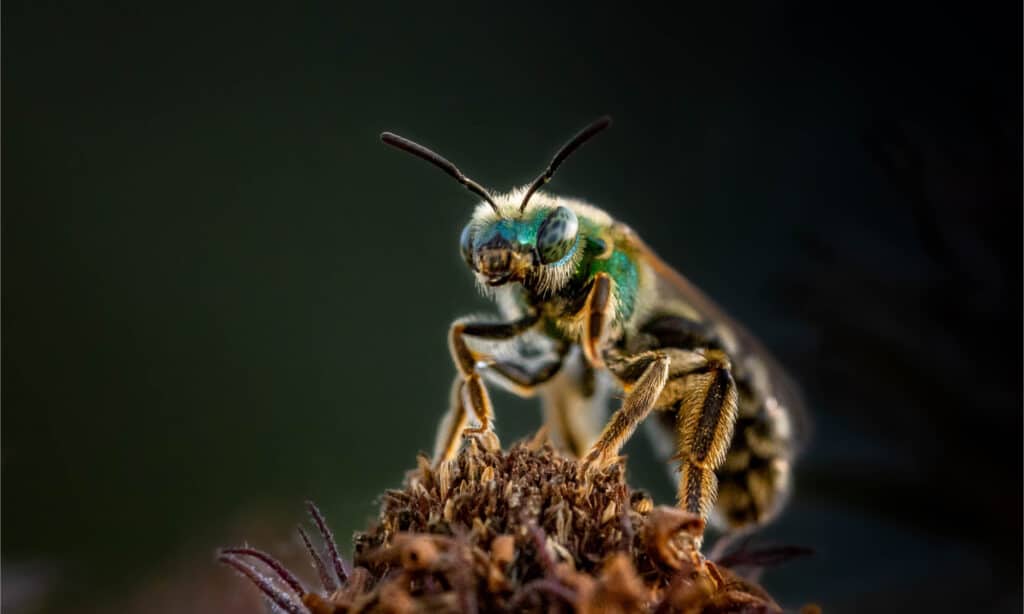
Sweat bee.
©d murk photographs/Shutterstock.com
Sweat bees, belonging to the Halictidae family, are a diverse group of small to medium-sized bees found throughout Illinois. They are named “sweat bees” due to their attraction to human sweat, which provides them with essential minerals like salt.
Physical Characteristics
Sweat bees exhibit a wide range of colors and sizes, from metallic green or blue to black with yellow or white markings. They are generally smaller than honey bees and bumblebees, measuring between 0.1-0.4 inches in length. While some species are relatively hairless, others have a more fuzzy appearance.
Where They Swarm in Illinois
Sweat bees are common in Illinois, from rural areas to urban gardens, and seem to prefer areas with an abundance of flowering plants. Swarming is not common in sweat bees, as they are generally solitary or semi-social insects. But during the mating season, males may fly in search of females, creating the appearance of swarming.
Species Found in Illinois
There are numerous sweat bee species in Illinois, including:
- The green sweat bee (Agapostemon virescens) is famous for its striking metallic green coloration.
- The alkali sweat bee (Halictus ligatus) features a black-and-yellow-striped abdomen.
5. Leafcutter Bees (Megachile spp.)
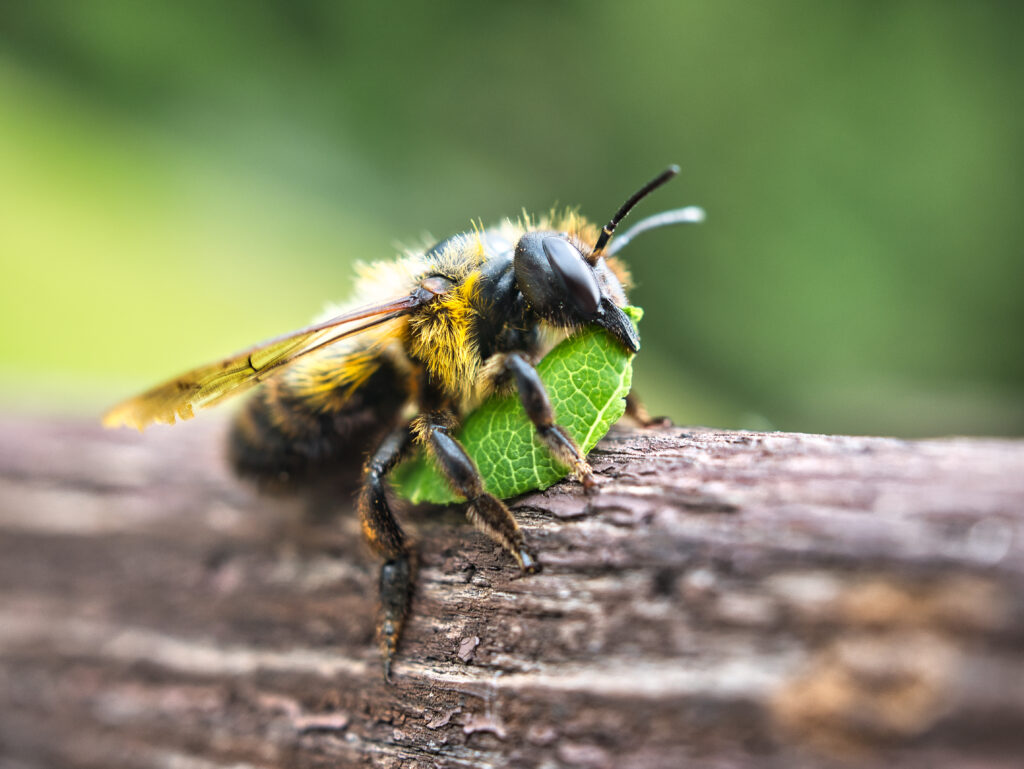
Leafcutter bee.
©Maurice Lesca/Shutterstock.com
Leafcutter bees, members of the genus Megachile, are a group of solitary, cavity-nesting bees. They have a unique behavior of cutting pieces of leaves to construct their nests.
Physical Characteristics
Leafcutter bees are generally medium-sized and robust, with a hairy appearance. They exhibit a range of colors, from black to brown or gray, often with pale hair bands on the abdomen. Leafcutter bees have large mandibles, enabling them to cut pieces of leaves or petals for nest construction.
Where They Swarm in Illinois
Leafcutter bees thrive in a variety of habitats across Illinois, from forests and meadows to urban gardens. They seem to prefer areas with an abundance of flowering plants and suitable nesting sites. Swarming behavior is uncommon in these solitary bees, although males may fly in search of females during the mating season, giving the appearance of swarming.
Species Found in Illinois
There are several leafcutter bee species in Illinois, including:
- The alfalfa leafcutter bee (scientifically known as Megachile rotundata) is a key pollinator for alfalfa crops.
- The rose leafcutter bee (Megachile centuncularis) prefers rose leaves when constructing its nests.
6. Mason Bees (Osmia spp.)

Mason bee.
©Jaco Visser/Shutterstock.com
Mason bees, belonging to the genus Osmia, are a group of solitary, cavity-nesting bees. They show unique nesting habits, which involve using mud or other materials to build partitions in their nests.
Physical Characteristics
Mason bees are typically small to medium-sized and are often metallic blue, green, or black in color. They have a robust appearance, with a hairy body and a pair of powerful mandibles, which they use to collect and manipulate materials for nest construction.
Where They Swarm in Illinois
Mason bees thrive in a variety of habitats across Illinois, from forests and meadows to urban gardens. They prefer areas with an abundance of flowering plants and suitable nesting sites. Swarming behavior is uncommon in these solitary bees, although males may fly in search of females during the mating season, giving the appearance of swarming.
Species Found in Illinois
There are several mason bee species in Illinois, including:
- The blue orchard mason bee (known scientifically as Osmia lignaria) is an important pollinator for fruit trees.
- The horn-faced mason bee (Osmia cornifrons) features distinct horn-like projections on the face of the female.
7. Mining Bees (Andrenidae family)
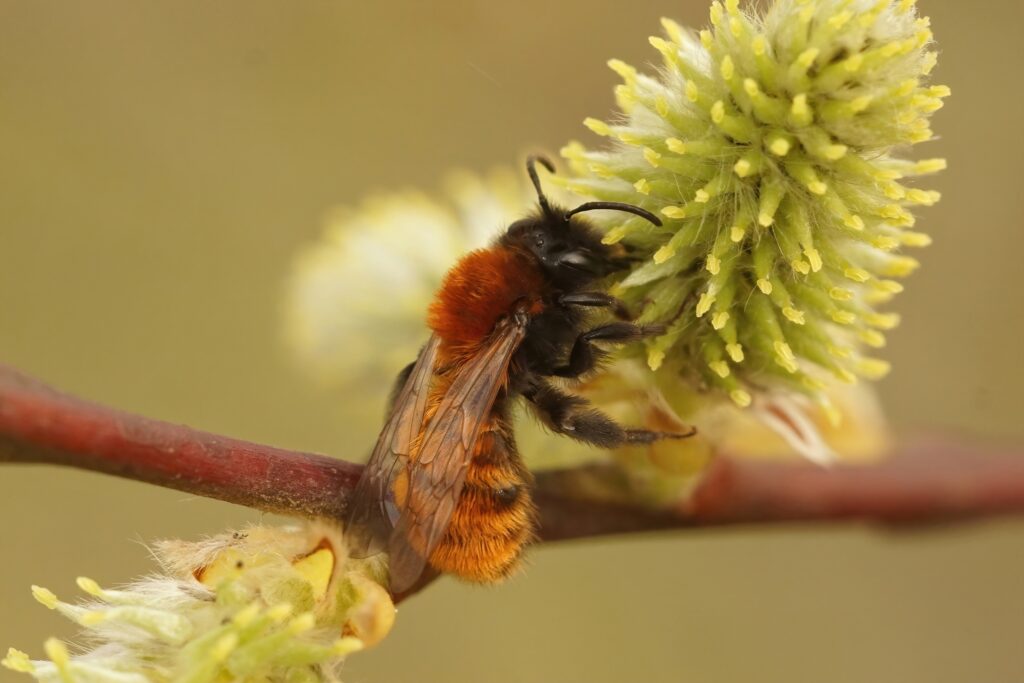
Mining bee.
©HWall/Shutterstock.com
Mining bees, members of the Andrenidae family, are a diverse group of solitary ground-nesting bees that live throughout Illinois. They are famous for their habit of excavating nests in the soil, often in sandy or well-drained areas.
Physical Characteristics
Mining bees exhibit a wide range of sizes and colors, from black to brown or reddish, often with pale hair bands on their abdomen. They’re generally small to medium-sized, with a robust and hairy appearance. Female mining bees have specialized hairs on their hind legs for collecting pollen.
Where They Swarm in Illinois
Mining bees thrive in various habitats across Illinois, from forests and meadows to sandy soils and urban gardens. They prefer areas with an abundance of flowering plants and suitable nesting sites. Swarming behavior is uncommon in these solitary bees, although males may fly in search of females during the mating season, giving the appearance of swarming.
Species Found in Illinois
There are numerous mining bee species in Illinois, including:
- The spring beauty mining bee (Andrena erigeniae) specializes in pollinating spring beauty flowers.
- The western mining bee (Andrena astragali), known to pollinate legumes
Each species has its own preferred habitat, food sources, and nesting requirements.
8. Long-Horned Bees (Eucerini Tribe)
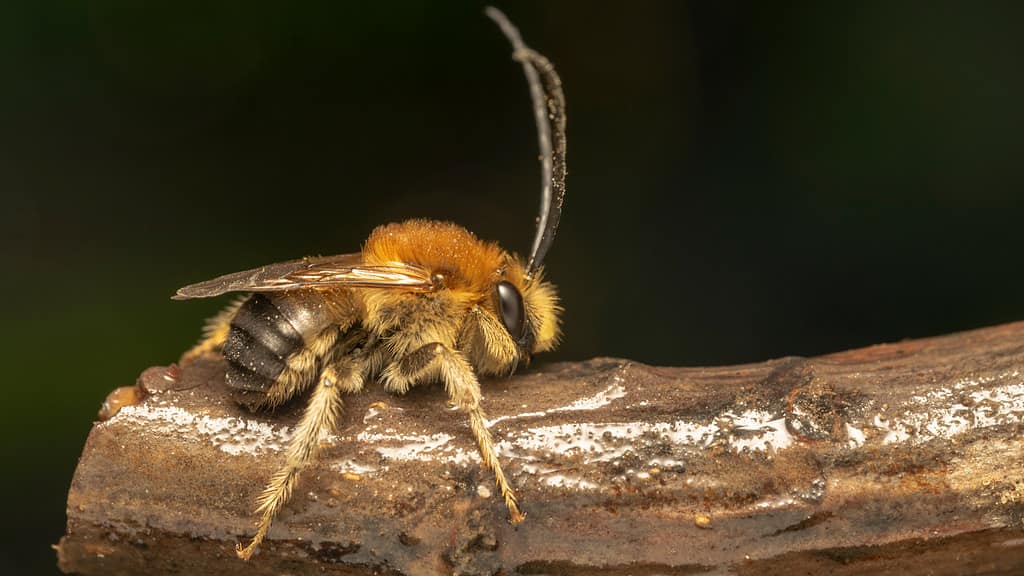
Long-horned bee.
©tasnenad/Shutterstock.com
Long-horned bees, members of the Eucerini tribe, are a group of solitary bees known for the elongated antennae of the males, which give them their name.
Physical Characteristics
Long-horned bees are generally medium-sized and robust, with a hairy appearance. They exhibit a range of colors, from black to brown or reddish, often with pale hair bands on their abdomen. The most distinctive feature of long-horned bees is the elongated antennae of the males, which are noticeably longer than those of the females.
Where They Swarm in Illinois
Long-horned bees thrive in a variety of habitats across Illinois, from forests and meadows to urban gardens. They prefer areas with an abundance of flowering plants and suitable nesting sites. Swarming behavior is uncommon in these solitary bees, although males may fly in search of females during the mating season, giving the appearance of swarming.
Species Found in Illinois
There are several long-horned bee species in Illinois, including:
- The sunflower long-horned bee (Svastra obliqua), which specializes in pollinating sunflowers.
- The squash long-horned bee (Peponapis pruinosa) is an essential pollinator for squash and pumpkin plants.
Each species has its own preferred habitat, food sources, and nesting requirements.
9. Cuckoo Bees (Nomada spp.)
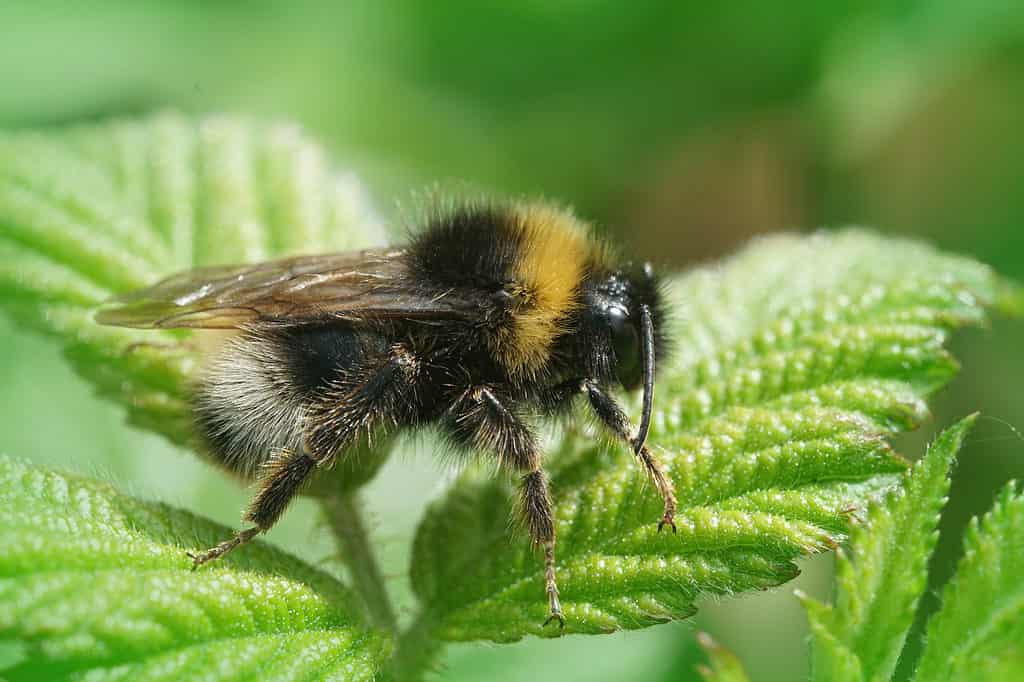
Cuckoo bee.
©Wirestock Creators/Shutterstock.com
Cuckoo bees, belonging to the genus Nomada, are a group of cleptoparasitic bees. Unlike most other bee species, cuckoo bees do not collect pollen or build their own nests. Instead, they lay eggs in the nests of other bee species, typically those of mining bees (Andrenidae family). As a result, they play a unique role in the ecosystem.
Physical Characteristics
Cuckoo bees are typically small to medium-sized bees with a wasp-like appearance, characterized by their slender bodies and relatively hairless, often brightly colored abdomens.
They exhibit a range of colors, including red, yellow, and black, with contrasting patterns that make them easily distinguishable from other bee species.
Where They Swarm In Illinois
Cuckoo bees thrive in various habitats across Illinois, from forests and meadows to urban gardens, often in areas where their preferred host species are present. Swarming behavior is uncommon in these parasitic bees, although males may fly in search of females during the mating season, giving the appearance of swarming.
Species Found in Illinois
There are several cuckoo bee species in Illinois, including:
- The common red cuckoo bee (Nomada ruficornis)
- The golden nomad cuckoo bee (Nomada fervida)
Each species has its own preferred host species and habitat requirements.
10. Digger Bees (Anthophora spp.)

Digger bee.
©Michael Siluk/Shutterstock.com
Digger bees, members of the genus Anthophora, are a group of solitary ground-nesting bees.
Physical Characteristics
Digger bees are generally medium-sized and robust, with a hairy appearance. They exhibit a range of colors, from black to brown or gray, often with pale hair bands on their abdomen or thorax. Digger bees have long tongues, enabling them to access nectar from tubular flowers that may be difficult for other bee species to reach.
Where They Swarm in Illinois
Digger bees thrive in a variety of habitats across Illinois, from forests and meadows to urban gardens. They prefer areas with an abundance of flowering plants and suitable nesting sites. Swarming behavior is uncommon in these solitary bees, although males may fly in search of females during the mating season, giving the appearance of swarming.
Species Found in Illinois
There are several digger bee species in Illinois, including:
- The eastern carpenter digger bee (Anthophora abrupta) is famous for its distinctive black-and-white coloration.
- The common anthophora digger bee (Anthophora terminalis) is characterized by its grayish-brown color and rapid flight.
Key Takeaways
The Prairie State of Illinois is home to a rich and diverse array of bee species, each with its own unique characteristics and ecological roles. These incredible insects play a crucial part in maintaining healthy ecosystems and supporting agricultural production. The survival of bees is closely intertwined with our own, as they play a critical role in the production of the food we eat and the health of our planet. By raising awareness and promoting the importance of bees, we can work together to ensure a brighter future for both these fascinating creatures and ourselves.
Bonus: Does Local Honey Prevent Allergies?

Local honey is a favorite purchase at farmer’s markets.
©Lizavetta/Shutterstock.com
If you are a seasonal allergy sufferer you have probably heard that small amounts of local honey can keep symptoms at bay. Does it really work? The idea is based on the concept of immunotherapy and makes plenty of sense. You take a tiny amount of the thing you are allergic to and over time and with bigger doses – your body builds up immunity to the allergen. Allergy shots work in the same way.
People believe that eating local honey works the same way because it contains local pollen. There are two problems – one, you may not be allergic to the specific pollen in the honey, and two, insect-borne pollen from flowers has nothing to do with allergies. Pollen from weeds, trees, and grasses that are whipped by the wind into the air is the main cause of seasonal allergies.
Local honey is also a problem for people who are actually allergic to bees. Unprocessed honey may contain small amounts of bee venom and could cause a severe reaction. Local honey may not be a cure-all – but honey does have antioxidants that help fight viruses and is an effective cough remedy. However, if you are allergic to bees – stick to processed honey from the grocery store.
The photo featured at the top of this post is © olko1975/Shutterstock.com
Thank you for reading! Have some feedback for us? Contact the AZ Animals editorial team.






